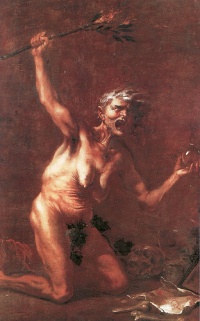-
A Funny Thing Happened on His Way to the Movies « OMBRES BLANCHES
Did Dulac betray Artaud’s intentions? -
Morbid Anatomy: Wonderful Depiction of a Popular Anatomical Museum, 1913
“A. Friedländer, Plakat für ein anatomisches Museum, Hamburg, 1913” -
documents: Mauss / Bataille (part 1)
There is a strong thematic unity between the teachings of the great French ethnologist Marcel Mauss and the work of the so-called ‘philosopher of evil’, Georges Bataille: sacrifice, the sacred, power, shamanism, secret societies are themes that were taken up by Mauss and figured largely in Bataille’s oeuvre. -
Cimetières dans la falaise [Cemeteries in the cliffs] « >dmtls Merzbau
documentary by Jean Rouch on the Dogon [in Mali], shot during a 1950-1951 expedition with Marcel Griaul. Witness sacred death and burial rituals -
Propaganda Postcards of the Great War – Alberto Martini (1)
Introducing Alberto Martini’s horrific cartoons -
DC’s: The day my blog becomes a movie projector, screen, a bunch of folding chairs, and a storefront in a bad part of town in honor of Bruce Conner
Dennis Cooper on Bruce Connor
-
The art of Jean-Paul Faccon
Another European artist who enjoys invented and ruined architecture.
Monthly Archives: January 2008
82 tracks from 34 of The WIRE’s Top 50 albums from 2007
Listen to 82 tracks from 34 of The WIRE’s Top 50 albums from 2007 at Swen’s blog
The whole list: The WIRE – 50 Records of The Year 2007
The Wire is a British avant garde music magazine. It was founded in 1982 by jazz promoter Anthony Wood and journalist Chrissie Murray, and concentrated on contemporary jazz and improvised music. From about 1990 it branched out into covering left-field rock and “post-rock” (a term coined in the pages of The Wire), hip hop, modern classical, free improvisation and various forms of electronic music.
A day at the beach and season’s greetings!
Eye candy #5

Previously on Eye Candy.
Blazon of the Ugly Tit

Contreblason du Tetin (1535) (Eng: Blazon of the Ugly Tit) is a poem by Clément Marot on ugly female breasts. Here in a translation by Helene Marmoux [1]. Clément Marot (1496–1544), was a French poet of the Renaissance period, for his poems on body parts, known as blasons and contreblasons. The ugly woman is a surprisingly common figure in Renaissance poetry, one that has been frequently appropriated by male poetic imagination to depict moral, aesthetic, social, and racial boundaries. The subject has been treated in dept by Patrizia Bettella in The Ugly Woman: Transgressive Aesthetic Models in Italian Poetry from the Middle Ages to the Baroque ( 2005).
Tit, skinny tit,
flat tit that looks like a flag,
big tit, long tit,
tit, must I call thee bag?
Tit with its ugly black end,
forever moving tit.
Who would boast having touched you?
With their hand fondle you? more…
Tip of the hat to On Ugliness
Unusual westerns
[Youtube=http://www.youtube.com/watch?v=FYdYIISecWE&]
[Youtube=http://www.youtube.com/watch?v=xrRLrJb01T8]
Matalo! (Eng: Kill Him!) is a 1970 western film directed by Cesare Canevari, considered one of the most violent and original spaghetti westerns. Released in France as Matalo and in Germany as Willkommen in der Hölle.
Other unusual westerns include:
- Se sei vivo spara, Giulio Questi, 1967
- Lonesome Cowboys, Andy Warhol, 1968
- Matalo!, Cesare Canevari, 1970
- El Topo, Alejandro Jodorowsky, 1970
- Lust in the Dust, Paul Bartel, 1985
- Unforgiven, Clint Eastwood, 1992
- Brokeback Mountain, Ang Lee, 2005
RIP Alain Payet (1947 – 2007)
Nathalie rescapée de l’enfer / Nathalie, Fugitive from Hell (1978) – Alain Payet
Alain Payet (January 17, 1947 – December 13, 2007) was a French writer-director.
Payet started his career in regular cinema as second assistant director on Philippe Labro‘s L’ Héritier (The Exterminator), which starred Jean-Paul Belmondo.
He directed 1970s Nazi exploitation movies (Nathalie, Fugitive from Hell) and “porno chic” features. He also made “porn versions” of some famous French films such as Astérix, Les Tontons flingueurs, and Les Visiteurs.
He died of cancer in Paris.
Eye candy #4
Surprising about the book, is that it is as much about literature than about visual culture. A big disappointment is that two times Eco says that “decency forbids us to reproduce such and such excerpt,” a childish remark. New authors and works discovered so far is Teofilo Folengo‘s Baldus (1517), of who Eco says that it was an important source of inspiration for Rabelais and Hieronymus Bosch.
In the beginning of the book, Eco makes a feeble attempt to come to a three-fold aesthetics of the ugly, but he never returns to his framework.
Actually, his thematics are not really the ugly, but the aestheticization of the ugly, a concept we know better as the grotesque, and which has been treated by such authors as Wolfgang Kayser in his The Grotesque in Art and Literature (which I have yet to read).
For those of you unfamiliar with the work of Salvator Rosa:
Salvator Rosa (1615 – March 15, 1673) was an Italian painter, poet and printmaker best known as an “unorthodox and extravagant” and a “perpetual rebel” proto-Romantic. His life and writings were equally colorful. Some sources claim he spent time living with roving bandits. Ann Radcliffe was greatly influenced by the Italian landscape painter and his dramatic landscapes peopled with peasants and banditti. Radcliffe managed to translate Rosa’s visual feeling of awe and the sublime to the Gothic novel popular in the 18th and 19th centuries.
Rosa is canonical to me despite of Huxley’s negative criticism:
- “Another more celebrated fantasist was Salvator Rosa — a man who, for reasons which are now entirely incomprehensible, was regarded by the critics of four and five generations ago as a great artist. But Salvator Rosa’s romanticism is pretty cheap and obvious. He is a melodramatist who never penetrates below the surface. If he were alive today, he would be known most probably as the indefatigable author of one of the more bloodthirsty and adventurous comic strips.” —Aldous Huxley, Prisons (1949)
Previously on Eye Candy.
Farewell Woebot (2003 -2008)
Sad, after Giornale Nuovo quit last year, musical blog Woebot decided to do the same. He will be sorely missed. If you are new to his writing just check his penultimate entry on jazz.
Questions have been raised (by John Coulthart amongst others, though I can’t find his post) on what will happen to the archives of the writing of these wonderful blogs. Other than books, which are disseminated, web content is stored in a centralized fashion. If a source disappears, it’s usually gone forever. Services such as the Wayback machine may help. Check the archives for Woebot there.
RIP Ettore Sottsass (1917 – 2007)
Unidentified photograph of Ettore Sottsass
Carlton Cabinet (1981) – Ettore Sottsass
Invitation to the first Memphis presentation, Sept 18 1981,
graphics by Luciano Paccagnella.
image sourced here

Ettore Sottsass Olivetti Valentine, first released on Valentine’s Day 1969.
Ettore Sottsass (14 September 1917 – 31 December 2007) was an Innsbruck-born Italian architect and designer of the late 20th century. He founded the Memphis Group and was a member briefly flirted with the Situationist International for a (very) short time. He was also connected to the radical design movement. His best-known product is the 1969 Olivetti Valentine typewriter. His 1981 “Carlton Cabinet” was to many people their first de facto exposure to postmodernism.
Sottsass founded the Memphis Group, an influential postmodern Italian design and architecture movement of the 1980s. Memphis explored a visual language outside of the limiting canons of “good taste,” blurring the boundaries between “high culture” and mass-produced “ordinary” consumer goods.
Radical design developed in Italy in the late 1960s and early 1970s. It continued the tradition of using new materials and bold colours that began with Pop Art but also drew on historical styles such as Art Deco, Kitsch, and Surrealism. The main exponents of Radical Design were small groups of architects and designers who questioned Modernism and rejected mass-consumer culture. Key groups and designers of the Radical style include Superstudio, Archizoom Associati, UFO, Gruppo Strum, and Ettore Sottsass.


















